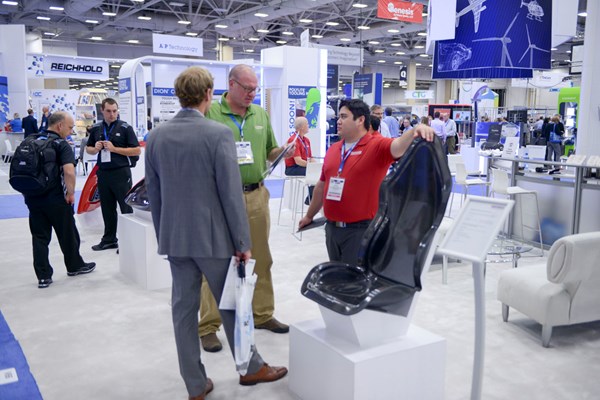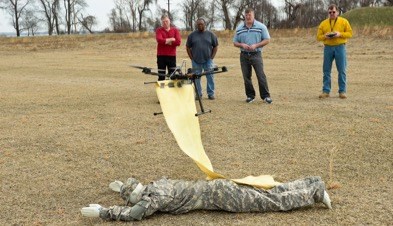CAMX 2015: Automotive, military innovations and on-floor demos
ACMA’s and SAMPE’s second combined event featured plenty of new products and thought-provoking conference sessions for the composites industry.

One presentation that stood out was from Axel Boettcher, owner of Boettcher Consult, where he discussed the high potential and expectations for carbon fiber in automotive. Automotive OEMs continue to work to reduce the weight of their vehicles due to global legislation setting a mandate to reduce vehicle emissions. As a result, there are high expectations for carbon fiber in automotive as it gives the best mechanical performance/component strength per weight, Boettcher said.
He addressed why carbon fiber composites are of interest in automotive and also covered the technical, political, social and economic issues associated with carbon fiber. He also looked into market considerations and production technologies being pursued (RTM, HP-RTM, wet pressing, prepreg, SMC, BMC and organo-sheet methods).
So as fuel consumption relates to less emissions, reducing the weight allows the best option for fuel reduction. The forecast for the next five to 10 years is that there will be more of a demand in weight reduction and the biggest potential to achieve this lies at structural components.
Boettcher took a closer look at resin choices—thermosets vs. thermoplastics—and their pros and cons. With thermosets, the benefits include chemical resistance and structural integrity. But the limitations of thermoset-based CFRPs include the long process times and and it is difficult to achieve a good surface finish. Whereas thermoplastics allows remolding without impacting physical mechanical properties, provides superior surface finish, “eco-friendly” manufacturing and high impact resistance. A drawback of thermoplastics is high viscosity and high melt temperatures.
As far as where composites are leaning more toward, Boettcher said that OEMs can save more weight and have higher performance with thermosets, but in thinner applications like bumpers, they tend to choose thermoplastic.
Generally speaking, plenty of barriers for widespread adoption remain as the high cost of carbon fiber is three times that of aluminum. There’s also the high cost investment of production, particularly with organo sheets. Another issue is the lack of technology competence and shortage of qualified composites workers.
BMW has lead the way of carbon fiber usage in automotive such as in its i Series. And while carbon fiber has been used in exotic race cars and sports cars, Boettcher said the goal should be to find a way to boost volumes to 50,000 cars a year. But to get there, the industry needs to advance automation beyond the early stages.
“Carbon fiber growth will exceed expectations,” Boettcher said. “Regulations are driving innovation primarily and technical performance to a lesser extent.”
It was a packed house for the presentation by Shawn Walsh, a researcher at the U.S. Army Research Laboratory whose paper is a CAMX 2015 Technical Paper Award winner. In his overview, Walsh said that the success of autonomous systems in military operations offers a unique opportunity to diversify the inherent and desirable performance characteristics of composite materials. “Composite materials” could include fiber reinforced matrices; but the definition could also include hybridized and multifunctional material systems that maximize capability (e.g., structural, ballistic, power) per unit weight of a given component, structure or system. The focus of the group’s research is to begin to demonstrate the largely unexplored opportunities to exploit the inherent and disruptive materials-enabled potential of autonomous systems. For example, composite materials developed for personnel protection (Kevlar or Dyneema helmets and body armor) have to meet multiple and stringent penetration resistance and back face deformation constraints. This often leads to the use of premium composite materials like Dyneema and Spectra materials in an effort to deliver the lightest, most effective protection.
However, Walsh said that by contrast, autonomous systems could augment personnel protection using far more affordable materials and defeat mechanisms. An autonomous system could be sacrificial and as such serve as a disruptive driver for composite materials to exploit and enable stand-off, improved multi-hit ballistic resistance and exploit on-board power and precision delivery of robotic systems capability. For instance, Walsh said that instead of thinking about personal protection as being attached to an individual or a vehicle, it’s about how to use technologies in the environment to reduce the effectiveness of projectiles in the area.
People associate unmanned systems with drones while at the same time, when it comes to solider protection, people believe more body armor is needed. But the Army Research Lab is working on a research project called Robotic Augmented Soldier Protection (RASP), which is designed to protect or replenish troops in combat. Walsh said the unmanned system could deliver to a wounded soldier a ballistic blanket for protection in an active hostile environment. This could be a blanket equipped with sensors to monitor the soldier’s condition or contain first aid care all designed to give soldiers extra help. Lower cost materials and novel architectures could be engineered to resist or degrade projectiles more efficiently and affordably. Some of the armor concepts include harvesting and diversifying polymer and composite technologies from helmet and body armor materials for applications in robotic-based protection concepts.

Early concept demo: Unmanned aerial vehicle (UAV) delivery of “smart blanket” with added frag protection for wounded soldier.
Some of the products featured
Covestro (Pittsburgh, PA, US, formerly Bayer MaterialScience) showcased a composite pallet utilizing its polyurethane. The approach begins with polyurethane resin that is pultruded to form lightweight composite pallets. The company says that this resolves many of the issues the material handling industry faces related to traditional wood or polymer block pallets. Pallet maker RM2 (Luxembourg and Chatham, NJ, US) pultrudes Covestro’s BaydurPUL 2500 polyurethane system to form its BLOCKPal composite pallet. Specifically designed for use in pultrusion, this Baydur formulation’s properties – including strength, toughness and impact resistance – reportedly offer improvements over what can be achieved with traditional pallet materials. A Life Cycle Analysis (LCA) commissioned by RM2 indicates only 899 BLOCKPal pallets are required for 100,000 one-way trips. By comparison, five times as many wooden pallets – 4,400 – would be required to make the same number of one-way trips.

The LCA also indicates that due to its lighter weight, lower loss rate enabled by ERICA and longer life, the BLOCKPalTpallet has a 21 percent lower global warming potential (GWP) impact and 50 percent lower total Primary Energy Demand than a typical wood block pallet.
The pallets have been independently tested by the Virginia Tech Center for Packaging and Unit Load Design and, according to RM2, regularly exceed industry standards. The Virginia Tech testing also demonstrated that the composite material utilized by BLOCKPal significantly increased pallet lifespan.
Sicomin (Marseille, France) recently opened a new dedicated U.S. distribution facility. The development is part of the company’s on-going global expansion plan and supports an already established network in Europe, Asia and Australasia. At CAMX, the company discussed its Fire Retardant range, bio-resin systems (Greenpoxy 56 and SurfClearEvo) and Clear (TOPClear) systems. Sicomin Export Manager Marc Denjean told CW that that the company is experiencing an increased interest in its bio-resin systems, particularly from the the sports/leisure field.
HK Research (Hickory, NC, US) presented its MetalFlex polymer gel coats. The MetalFlex gel coats are based on the company’s acrylic modified 100% NPG/isophthalic polymer backbone and formulated to meet the need for composite gel applications. It can be formulated into “high-def” rich-tone colors. The gels are blush resistant, user friendly (flow, leveling and air release) and are easily repaired. The company is also showcased its HDS Series swimming pool and spa gel coat, which can be formulated into “rich-tone glitter colors” as well as in white and off-whites. HK Research says the gel coats have been tested and proved at above-normal temperature and chemical (chlorine and bromide) levels for resistant to blistering and surface distortion.
Earlier this year, HK completed an expansion of its production facility in Hickory. The expansion increased floor space dedicated to gel coat production by a factor of more than 50%. The company added 10 new state-of-the art variable speed large tank mixers, eight variable speed multi- drum mixers and two powerful grind/shear mixers as part of the expansion. Six custom stainless steel mixing vessels were designed and purchased, specifically for the custom color operation for batch sizes up to 13-drum quantities. Several modern high-capacity precision scales were also added so these gel coats can be compounded with superior accuracy. These additions give HK Research the ability to produce a greater volume of its gel coats on a daily basis. The company also recently purchased land adjacent to its production facility, where it plans to build a material warehousing site in the future.
Composites One, along with the Closed Mold Alliance and more than 20 industry partners, presented closed molding and advanced process demonstrations during CAMX.

Related Content
Plant tour: Joby Aviation, Marina, Calif., U.S.
As the advanced air mobility market begins to take shape, market leader Joby Aviation works to industrialize composites manufacturing for its first-generation, composites-intensive, all-electric air taxi.
Read MoreMaterials & Processes: Fabrication methods
There are numerous methods for fabricating composite components. Selection of a method for a particular part, therefore, will depend on the materials, the part design and end-use or application. Here's a guide to selection.
Read MoreThe state of recycled carbon fiber
As the need for carbon fiber rises, can recycling fill the gap?
Read MoreJeep all-composite roof receivers achieve steel performance at low mass
Ultrashort carbon fiber/PPA replaces steel on rooftop brackets to hold Jeep soft tops, hardtops.
Read MoreRead Next
From the CW Archives: The tale of the thermoplastic cryotank
In 2006, guest columnist Bob Hartunian related the story of his efforts two decades prior, while at McDonnell Douglas, to develop a thermoplastic composite crytank for hydrogen storage. He learned a lot of lessons.
Read MoreComposites end markets: Energy (2024)
Composites are used widely in oil/gas, wind and other renewable energy applications. Despite market challenges, growth potential and innovation for composites continue.
Read MoreCW’s 2024 Top Shops survey offers new approach to benchmarking
Respondents that complete the survey by April 30, 2024, have the chance to be recognized as an honoree.
Read More










.jpg;maxWidth=300;quality=90)















